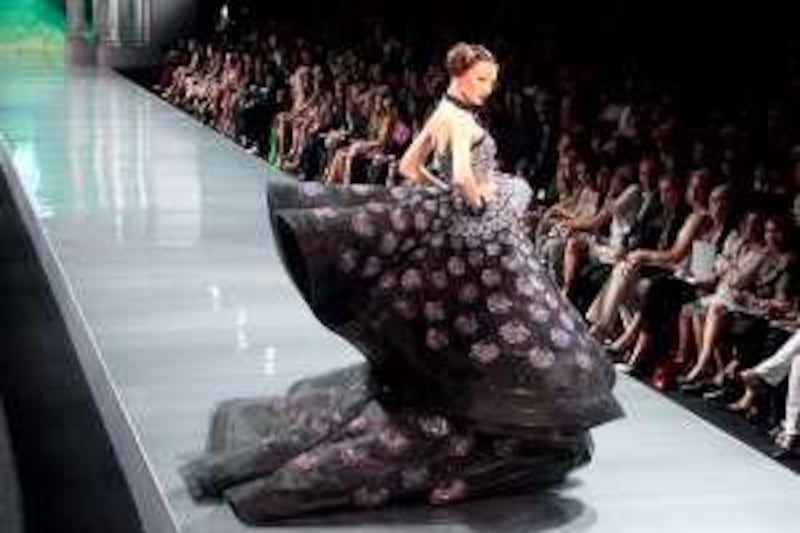If proof were needed of the existence - and, now, the resilience - of the super rich, it would come from French haute couture. Look at who wears it and you are contemplating some of the wealthiest, most fashion-conscious inhabitants of the planet. Little wonder that so many eyes are on the 1,500 or so women who will be selecting their spring/summer wardrobes in Paris during this week's haute couture shows starting today.
But there is a difference that is evident to designers and seasoned observers alike. Traditionally, Americans account for 60 per cent of haute couture clients. But given the worst economic conditions for half a century, with the US hit particularly hard, times are changing. The industry is now fuelled by dedicated followers of fashion from other nations, particularly the Middle East. Last July, following an especially glitzy couture season, Sidney Toledano, the president of Christian Dior, boasted to the American clothing oracle, Women's Wear Daily, that "the demand for very high-end products continues to be very strong. Very rich people are not suffering from the crisis and workshops have been very busy".
He pointed out that couture sales at Dior in 2008 followed the same "double-digit" growth pattern as in the previous year. What he did not add was that this could be attributed largely to emerging pockets of global wealth: a little in China and India, some more in Russia and a lot in the Middle East. It was staggering to witness at last July's haute couture show in Paris how much had changed even before the onset of the credit crunch.
A glance at the geography of the seating plan told its own story. Most noticeable by their absence were the skeletal American clients, those facelifted size zeros, now numbering just a handful. The area housing the bouffant grande dames of France ? Mesdames Chirac and Pompidou ? and various glamorous film stars had been slimmed down, replaced by the Russians. An entirely new section had sprung up devoted to the Chinese. And there were several more Indians and gracious Begums than many looking on could remember.
And guests, fashion journalists and TV people from the Middle East occupied by far the largest section. This stretched virtually the entire length of the vast marquee in the grounds of the Musée Rodin. In the front two rows sat well-to-do Arabs, from Qatar, Kuwait and Oman as well as from the UAE, looking across the catwalk to the seats of other VIPs including Janet Jackson, Claudia Schiffer, Marisa Berenson and Eva Mendes. American journalists, upset to find themselves several rows back, had to spend much of the show rubbernecking.
There has always been an Arab presence within haute couture, particularly as revered customers of Yves Saint Laurent, Ungaro, Chanel and Dior. But their significance is growing. "When oil prices rose in the 1990s so did the client base," says the Lebanese designer, Elie Saab, who will show his collection in Paris on Wednesday. "It became not the number of dresses per client but the number of clients that shot up."
The British couturier, Bruce Oldfield, who reckons that 30 per cent of his clients are women from the Middle East, agrees. "For sure the Paris couture houses are currently being supported by weddings from Middle Eastern clients and more recently Russian brides," says Oldfield, a favourite designer of the late Princess of Wales, whose clients include several Middle Eastern royal family members. "It is part of the Arab culture to dress up especially for weddings.
"Arab ladies want something luxurious and they want the 'wow' factor. They understand the value of the one-off gown. You don't want to be wearing the same dress as someone else in your social group and they also want the best luxury fabrics coming from a culture that has a heritage of elaborate textiles, embroidery and jewels." If you think back to the spectacular Nasser D Khalili Collection exhibition last year at the Emirates Palace hotel, much of the elaborate beading and gold threads would have been the equivalent of Lesage, the famous Parisian firm founded in 1922 by Albert Lesage and used by French haute couturiers such as Chanel.
It is not just the fact they can afford couture that makes having an Arab customer so vital to fashion houses. "Arabs are incredibly loyal," explains Oldfield. "Once you have a client they are yours for life and will bring in their daughter, then granddaughter and remember they have large families. For a wedding the whole family gets involved, so you have the bride, her sisters, perhaps her aunts and friends, all wearing £20,000 (Dh100,000) dresses. Many of my Arab clients will also order two or more of the same dress to keep in their various palaces."





